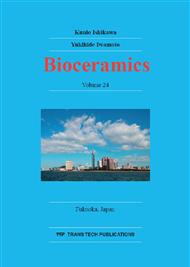p.187
p.192
p.197
p.202
p.207
p.213
p.217
p.223
p.229
Controlled Self-Coating of Implant Surfaces with Autologous Molecules
Abstract:
mplant fixation is correlated with direct bone apposition on the implant surface. In a former study it was reported that a new coating material enhances the bone-to-implant-contact in comparison to machined and rough surfaces. This study is aimed at clarifying the effect of an enhanced bone-to-implant-contact that is induced by a new coating material. The coating is produced by spin and spray coating and consists of a silica matrix, in which nanocrystalline hydroxyapatite is embedded. The coating material exhibits a high porosity in the micrometer and nanometer scale. Coated implants were inserted subcutaneously in Wistar Rats. The specimens were excised after 6 and 12 days. EDX and SEM analysis showed a reduction of the silica amount within 6 days. In accordance to former results of a bone grafting material with the same structure, this matrix change is responsible for an initial bone formation at early stages.
Info:
Periodical:
Pages:
207-212
Citation:
Online since:
November 2012
Authors:
Keywords:
Price:
Сopyright:
© 2013 Trans Tech Publications Ltd. All Rights Reserved
Share:
Citation:


